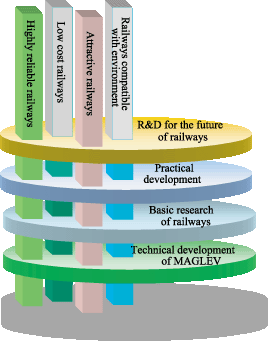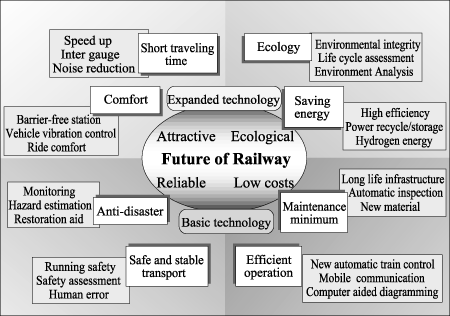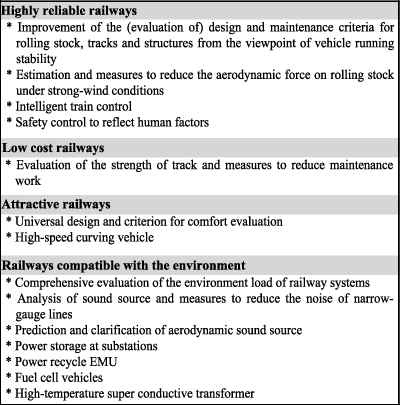
Fig.1 R&D activities in the RTRI fundamental plan
1. The new fundamental plan of RTRI
Railway Technical Research Institute (RTRI) has started research and development for five years from fiscal 2000 to 2004, under a new fundamental management plan called "RESEARCH 21". The aim is to realize railway systems that are "highly reliable," "low costs," "attractive" and "compatible with the environment," while focusing on "Projects for the future of railways". We established four research activities in which RTRI should engage.
They are projects for the future of railways, practical developments, basic researchers of railways and technical developments of MAGLEV shown in Fig.1. The appropriating funds will be three billion yen including government subsidies for fiscal 2001 and 12.6 billion yen in total for five years on the researchers related to conventional railway systems.

2. Projects for the future railways
These projects are defined as technological developments which will contribute to developments of future railway systems, aiming at completion in five to 10 year and challenging the extermination of problems that have remained unsolved.
In selecting future-oriented projects, RTRI placed priority on the needs of JR companies, customers and other railway companies. After privatized, JR companies have addressed technological development for high-speed operation and won success in running high-speed trains on various lines.
In recent years, however, the targets of technological development of different JR companies have diversified due to the ever-increasing differences in the regional transport conditions and management policies. To keep abreast of the development of airplanes and automobiles, it is also required for railways to correctly respond to the interest of young and senior people in travel and change the conventional railways into an attractive transport system.
Therefore we investigated key technologies which were required to develop railway systems and to prosper railway industry (Fig.2). In addition, based on the discussion with younger researchers of RTRI, we summarized methods of research that requires higher levels of expert knowledge, expected accomplishments and schedules for research activities on 14 projects (Table 1).

Table 1 Projects for the future of railways

3. Subjects of the projects
I will introduce some subjects of fourteen projects.
(1) Improvement of vehicle running stability
Derailment is caused by the static unbalance between wheel loads and their dynamic changes, excess attack angle of wheel, abnormal profile of wheel tread and irregularity of track. For that reason, we will clarify the phenomenon of derailment of the wheel climbing along the edge of rails. And we will investigate the mechanism of wheel climbing derailment on sharp curves with 200m radius by field tests and simulations.
(2) Estimation and reduction measures for aerodynamic force on vehicles
To prevent the overturn of vehicles due to strong winds, it is required to further improve the stability of train operation under windy conditions. We will estimate aerodynamic forces that act on vehicles of different profiles, determine the threshold wind speed for overturn with high precision, propose appropriate profiles of vehicle and wind prevention fence, and offer methods to ensure safety and minimize the time of restricted train operation based on results of these researches.
(3) Intelligent train operation control
A low cost train operation system by introducing a moving block system will be developed using radio communication methods. It is consisted of an on-board forward monitoring system to detect obstacles at crossings and stations by the image processing technology and a control system to support high-density train operation. Retrieve train operations from train disturbance using low cost mobile radio devices will be also developed.
(4) Universal design and evaluation of comfort for railway spaces
Railway companies are required to offer barrier-free stations and rolling stocks to passengers. We will develop methods to evaluate the easiness-to-use of station facilities, and simulate the movement of people on platforms and at staircases. We will also propose a method to comprehensively evaluate the ride comfort of rolling stock to reflect the conditions of temperature, humidity and seats, in addition to the criterion based on the frequency and amplitude of lateral vibration.
(5) High-speed curving vehicle
Car body tilting systems are effective to increase permitted speeds on curves. In such tilting systems, train overturning outward on curves. In such tilting systems, train overturning outward on curves has to be prevented. In order to increase speeds on curves more, we will develop the mechanisms to shift the center of gravity of tilted vehicle bodies into the lateral direction and to lower the tilting roll center to prevent motion sickness.
(6) Clarification of aerodynamic noise sources
The aims of this project is to clarify the mechanism that causes aerodynamic noise on Shinkansen cars that run at the speed of 300km/h or over by means of wind tunnel tests, field tests and numerical simulations. To locate the sources of aerodynamic noise, we will develop a sound collecting device that can analyze sound sources with high precision.
In addition, we will separate noise under floor of car bodies from other noise sources such as those on trucks, equipments under the vehicle floor, coupling between cars and other parts of complicated configuration. Based on the results of such researches, we will propose measures to reduce aerodynamic noise on Shinkansen cars.
(7) Power storage and super conductive transformer
As a means to save power consumption by electric railways, we will develop a power device to store the power produced by the regeneration brake system at substations or on rolling stock. The restored power is consumed later when necessary. An on-board transformer using high-temperature super conductive coils that can increase power efficiency and reduce the cost of power consumption will be developed.
(8) Fuel cell vehicles
Fuel cells are expected to provide a stand alone power generating system. While aiming at the realization of vehicles to replace diesel multiple units without noise and light rail transit vehicles without a catenary system, we will scrutinize the current characteristics and durability of fuel cells and develop a traction system to apply fuel cells for railway vehicles.
4. Future developments
The information technology (IT) has rapidly progressed in various industries. Under the circumstances, it is planned to positively introduce IT into the railway industry as a means of communication. In parallel with such movement, railways still have conventional issues that cannot be overlooked, such as prevention of derailment, measures against earthquake and other natural disasters and elimination of human errors in train operation and maintenance work.
RTRI will offer technologies that really contribute to the vitalization of railways on a timely basis and challenge new technological fields such as those of energy storage and new materials.